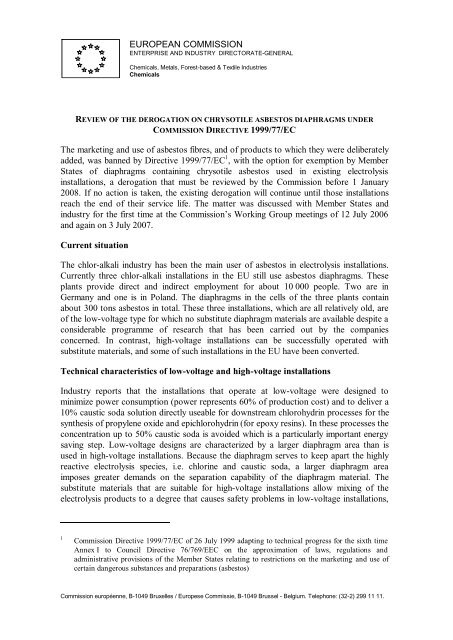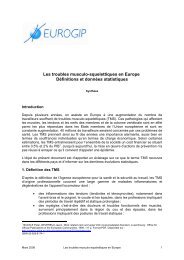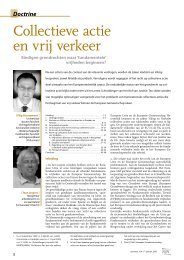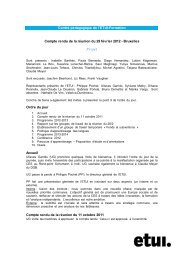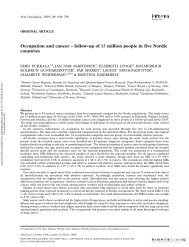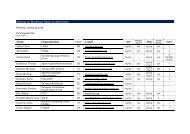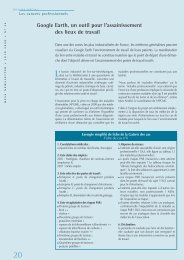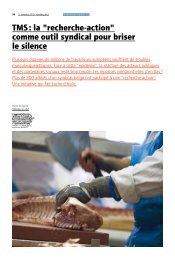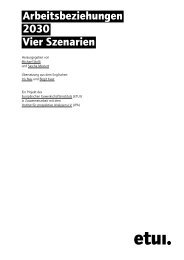Derogation on Chrysotile Asbestos Diaphragms under Directive ...
Derogation on Chrysotile Asbestos Diaphragms under Directive ...
Derogation on Chrysotile Asbestos Diaphragms under Directive ...
You also want an ePaper? Increase the reach of your titles
YUMPU automatically turns print PDFs into web optimized ePapers that Google loves.
EUROPEAN COMMISSION<br />
ENTERPRISE AND INDUSTRY DIRECTORATE-GENERAL<br />
Chemicals, Metals, Forest-based & Textile Industries<br />
Chemicals<br />
REVIEW OF THE DEROGATION ON CHRYSOTILE ASBESTOS DIAPHRAGMS UNDER<br />
COMMISSION DIRECTIVE 1999/77/EC<br />
The marketing and use of asbestos fibres, and of products to which they were deliberately<br />
added, was banned by <strong>Directive</strong> 1999/77/EC 1 , with the opti<strong>on</strong> for exempti<strong>on</strong> by Member<br />
States of diaphragms c<strong>on</strong>taining chrysotile asbestos used in existing electrolysis<br />
installati<strong>on</strong>s, a derogati<strong>on</strong> that must be reviewed by the Commissi<strong>on</strong> before 1 January<br />
2008. If no acti<strong>on</strong> is taken, the existing derogati<strong>on</strong> will c<strong>on</strong>tinue until those installati<strong>on</strong>s<br />
reach the end of their service life. The matter was discussed with Member States and<br />
industry for the first time at the Commissi<strong>on</strong>’s Working Group meetings of 12 July 2006<br />
and again <strong>on</strong> 3 July 2007.<br />
Current situati<strong>on</strong><br />
The chlor-alkali industry has been the main user of asbestos in electrolysis installati<strong>on</strong>s.<br />
Currently three chlor-alkali installati<strong>on</strong>s in the EU still use asbestos diaphragms. These<br />
plants provide direct and indirect employment for about 10 000 people. Two are in<br />
Germany and <strong>on</strong>e is in Poland. The diaphragms in the cells of the three plants c<strong>on</strong>tain<br />
about 300 t<strong>on</strong>s asbestos in total. These three installati<strong>on</strong>s, which are all relatively old, are<br />
of the low-voltage type for which no substitute diaphragm materials are available despite a<br />
c<strong>on</strong>siderable programme of research that has been carried out by the companies<br />
c<strong>on</strong>cerned. In c<strong>on</strong>trast, high-voltage installati<strong>on</strong>s can be successfully operated with<br />
substitute materials, and some of such installati<strong>on</strong>s in the EU have been c<strong>on</strong>verted.<br />
Technical characteristics of low-voltage and high-voltage installati<strong>on</strong>s<br />
Industry reports that the installati<strong>on</strong>s that operate at low-voltage were designed to<br />
minimize power c<strong>on</strong>sumpti<strong>on</strong> (power represents 60% of producti<strong>on</strong> cost) and to deliver a<br />
10% caustic soda soluti<strong>on</strong> directly useable for downstream chlorohydrin processes for the<br />
synthesis of propylene oxide and epichlorohydrin (for epoxy resins). In these processes the<br />
c<strong>on</strong>centrati<strong>on</strong> up to 50% caustic soda is avoided which is a particularly important energy<br />
saving step. Low-voltage designs are characterized by a larger diaphragm area than is<br />
used in high-voltage installati<strong>on</strong>s. Because the diaphragm serves to keep apart the highly<br />
reactive electrolysis species, i.e. chlorine and caustic soda, a larger diaphragm area<br />
imposes greater demands <strong>on</strong> the separati<strong>on</strong> capability of the diaphragm material. The<br />
substitute materials that are suitable for high-voltage installati<strong>on</strong>s allow mixing of the<br />
electrolysis products to a degree that causes safety problems in low-voltage installati<strong>on</strong>s,<br />
1 Commissi<strong>on</strong> <strong>Directive</strong> 1999/77/EC of 26 July 1999 adapting to technical progress for the sixth time<br />
Annex I to Council <strong>Directive</strong> 76/769/EEC <strong>on</strong> the approximati<strong>on</strong> of laws, regulati<strong>on</strong>s and<br />
administrative provisi<strong>on</strong>s of the Member States relating to restricti<strong>on</strong>s <strong>on</strong> the marketing and use of<br />
certain dangerous substances and preparati<strong>on</strong>s (asbestos)<br />
Commissi<strong>on</strong> européenne, B-1049 Bruxelles / Europese Commissie, B-1049 Brussel - Belgium. Teleph<strong>on</strong>e: (32-2) 299 11 11.
i.e. the risk of explosi<strong>on</strong> due to the str<strong>on</strong>gly exothermic nature of the reacti<strong>on</strong> of chlorine<br />
with hydrogen.<br />
The different physical lay-out of the installati<strong>on</strong>s also precludes the ec<strong>on</strong>omic c<strong>on</strong>versi<strong>on</strong><br />
of low-voltage installati<strong>on</strong>s to high-voltage operati<strong>on</strong>. Replacement of the low-voltage<br />
installati<strong>on</strong>s by high-voltage installati<strong>on</strong>s would effectively require a total rebuild of the<br />
plant, which is not c<strong>on</strong>sidered ec<strong>on</strong>omically viable for the three installati<strong>on</strong>s in questi<strong>on</strong>.<br />
Industry positi<strong>on</strong><br />
Industry reports that a research effort from 1975 to 2004 into potential substitute<br />
materials, e.g. polymeric and minerals, involving 200 man-years of effort and costing €37<br />
milli<strong>on</strong>, produced 63 internal reports and 29 patents, and did result in a number of fullscale<br />
tests in the period 1990-1998. However, n<strong>on</strong>e of the new materials performed<br />
adequately in low-voltage installati<strong>on</strong>s. The Interim Chemicals Review Committee of the<br />
Rotterdam C<strong>on</strong>venti<strong>on</strong> <strong>on</strong> the Prior Informed C<strong>on</strong>sent Procedure has listed 24 materials<br />
as possible alternatives to asbestos. Industry has assessed their technical feasibility for use<br />
as diaphragm materials and found that 22 materials were chemically unstable in the cell<br />
envir<strong>on</strong>ment, and the remaining two materials, polytetrafluoroethylene and graphite, were<br />
not suitable because of their wetting or electrical c<strong>on</strong>ductivity characteristics. The<br />
research programme is now c<strong>on</strong>sidered to have screened all potentially suitable candidate<br />
diaphragm materials and to have effectively exhausted all these possibilities.<br />
In view of the poor prospects for further technical developments, Industry argues for the<br />
c<strong>on</strong>tinued use of the low voltage installati<strong>on</strong>s, which is more energy efficient than the<br />
high-voltage installati<strong>on</strong>s, and for which the use of asbestos diaphragms poses no risk.<br />
Risks from the c<strong>on</strong>tinued use of asbestos diaphragms<br />
The handling of the asbestos diaphragms throughout their life-cycle, including their final<br />
disposal, has to be d<strong>on</strong>e in a way that c<strong>on</strong>forms to current legislati<strong>on</strong> e.g. <strong>on</strong> exposure of<br />
workers to asbestos fibres. In fact, potential for worker exposure exists <strong>on</strong>ly when<br />
diaphragms need replacing (lifetime up to 10 years) because the electrolysis cells are<br />
hermetically sealed during operati<strong>on</strong> to c<strong>on</strong>tain the chlorine gas. Industry reports that<br />
worker exposure limits for chrysotile are fully respected. For example, in Germany<br />
asbestos fibre c<strong>on</strong>centrati<strong>on</strong>s in air did not exceed the natural background levels, and in<br />
Poland bi-annual m<strong>on</strong>itoring by the authorities recorded values below the permitted limits 2<br />
for dust and fibre c<strong>on</strong>centrati<strong>on</strong>. The authorities in the two Member States have permitted<br />
the c<strong>on</strong>tinued operati<strong>on</strong> of the three installati<strong>on</strong>s, and have not expressed any c<strong>on</strong>cerns<br />
regarding their safety to the Commissi<strong>on</strong>.<br />
Summary and c<strong>on</strong>clusi<strong>on</strong>s<br />
It seems that industry has made a c<strong>on</strong>siderable effort to develop alternative diaphragm<br />
materials. The substitute materials have proved successful in high-voltage installati<strong>on</strong>s, but<br />
not in low-voltage installati<strong>on</strong>s. Moreover, the future prospects for developing further<br />
substitute diaphragm materials appear to be rather poor.<br />
2 The permitted level for total dust is 0.5mg/m 3 and for respirable fibres is 0.1 fibres/cm 3 .<br />
2
C<strong>on</strong>versi<strong>on</strong> of existing installati<strong>on</strong>s from low-voltage to high voltage operati<strong>on</strong> would<br />
appear to be expensive, and is not ec<strong>on</strong>omically viable given that the present installati<strong>on</strong>s<br />
operate as part of larger integrated plants. The Commissi<strong>on</strong> has not received any<br />
informati<strong>on</strong> to indicate that the c<strong>on</strong>tinued use of asbestos diaphragms c<strong>on</strong>stitutes a risk.<br />
Given that the technical difficulties in moving away from asbestos remain the same as<br />
when the derogati<strong>on</strong> was granted, and that the operati<strong>on</strong> of the installati<strong>on</strong>s has apparently<br />
not resulted in any risk, there do not appear to be grounds for withdrawing the<br />
derogati<strong>on</strong>.<br />
Member States and industry agreed with this assessment at the Commissi<strong>on</strong>’s Working<br />
Group meeting of 3 July 2007. The review therefore c<strong>on</strong>cludes that the derogati<strong>on</strong> can be<br />
maintained.<br />
3


